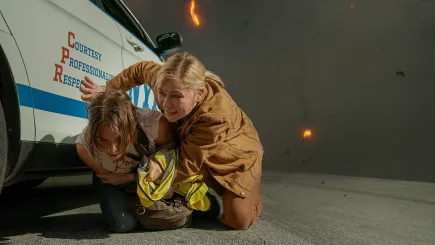In a cinematic landscape often inundated with superficial political narratives, Alex Garland’s “Civil War” emerges as a bold and unflinching exploration of America’s fractured psyche. Premiering to critical acclaim at the SXSW Film Festival, this dystopian thriller transcends the confines of conventional storytelling to offer a thought-provoking examination of the nation’s internal strife and its unsettling descent into chaos. Let’s find out with Whoworlds.
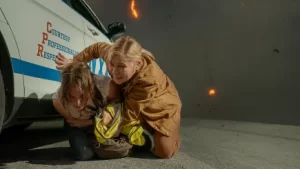
At the heart of “Civil War” lies Garland’s refusal to be bound by the trappings of contemporary American politics. Rather than engaging in a superficial analysis of the country’s two-party system or its current political landscape, Garland delves deeper, probing the underlying currents of factionalism and self-righteous exceptionalism that have long defined the American ethos. Through the lens of a group of intrepid journalists, led by the enigmatic Lee Smith (portrayed with steely resolve by Kirsten Dunst), the film offers a harrowing glimpse into a nation on the brink of collapse, where violence simmers just beneath the surface and the promise of stability feels increasingly tenuous.
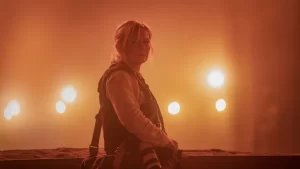
From its opening scenes, “Civil War” immerses viewers in a world ravaged by conflict, where the once-familiar landscapes of America have been transformed into battlegrounds and the rule of law has given way to the law of the jungle. Garland’s masterful direction, coupled with the evocative cinematography of DP Rob Hardy, creates a haunting tableau of destruction and despair, where abandoned highways and makeshift refugee camps serve as grim reminders of the nation’s descent into anarchy. Against this backdrop, Garland weaves a narrative that is as provocative as it is prescient, challenging viewers to confront uncomfortable truths about the nature of power, identity, and the human condition.
Central to “Civil War” is its ensemble cast, whose compelling performances breathe life into Garland’s vision of a nation in turmoil. Dunst’s portrayal of Lee Smith is a tour de force of emotional depth and vulnerability, as she grapples with the moral complexities of her profession and the weight of her own disillusionment. Likewise, Wagner Moura delivers a standout performance as Joel, a seasoned journalist whose stoic demeanor belies a deep sense of conviction and moral clarity. Together with a talented supporting cast that includes Cailee Spaeny, Stephen McKinley Henderson, and Nick Offerman, they imbue their characters with a sense of authenticity and humanity that grounds the film in emotional reality.
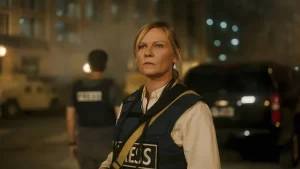
Yet, for all its intellectual ambition and visual prowess, “Civil War” is not without its flaws. Garland’s screenplay, while brimming with provocative ideas and philosophical musings, occasionally veers into didacticism, sacrificing subtlety for blunt social commentary. Likewise, the film’s pacing can feel uneven at times, with certain scenes dragging on longer than necessary while others feel rushed and underdeveloped. Additionally, the lack of diversity in the film’s predominantly white cast raises questions about representation and inclusion in a story that purports to speak to the broader American experience.
Despite these shortcomings, “Civil War” remains a captivating and thought-provoking work of speculative fiction, offering a chilling glimpse into a future that feels uncomfortably close to our own. As Garland grapples with questions of identity, morality, and the fragility of democracy, the film serves as a timely reminder of the dangers of complacency and the importance of remaining vigilant in the face of tyranny and oppression. In an era defined by political polarization and social unrest, “Civil War” stands as a powerful testament to the enduring power of cinema to provoke, inspire, and challenge our perceptions of the world around us.
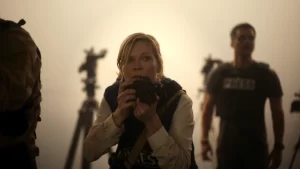
Beyond its narrative merits, “Civil War” also serves as a technical tour de force, with Garland and his team demonstrating a mastery of visual storytelling that is both immersive and evocative. From the stark chiaroscuro lighting of the film’s interior scenes to the sweeping vistas of a nation in turmoil, every frame is meticulously crafted to elicit maximum impact, drawing viewers deeper into the film’s dystopian landscape. Furthermore, the film’s sound design and score, composed by the acclaimed duo of Ben Salisbury and Geoff Barrow, enhance the atmosphere of tension and unease, heightening the emotional stakes and adding an additional layer of depth to Garland’s vision.
In conclusion, “Civil War” stands as a testament to the power of cinema to provoke, challenge, and inspire. With its bold narrative, compelling performances, and stunning visuals, Alex Garland’s dystopian saga offers a searing indictment of a society teetering on the brink of collapse. As the lines between truth and fiction blur and the specter of civil unrest looms ever larger, “Civil War” serves as a timely reminder of the fragility of democracy and the importance of remaining vigilant in the face of tyranny and oppression. In a world beset by division and discord, Garland’s film offers a beacon of hope, urging audiences to confront uncomfortable truths and work towards a brighter, more equitable future for all.
See more: The Ever-Evolving Tapestry of Global Travel: Trends, Tales, and Transformations

